|
|
| |
|
| |

Pioneers in
Arts, Humanities, Science, Engineering, Practice (PAHSEP)
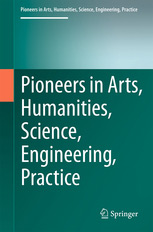
Edited by
Hans Günter Brauch,
AFES-PRESS, chairman
Free University of Berlin (Ret.)
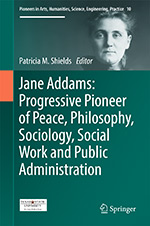
|
Patricia M. Shields (Ed.): Jane Addams: Progressive Pioneer of Peace, Philosophy, Sociology, Social Work and Public Administration (Cham- New York - Heidelberg - Dordrecht - London: Springer International Publishing, 2017).
ISBN: 978-3-319-50644-9 (Hardcover)
ISBN: 978-3-319-50646-3 (EBook)
Doi: 10.1007/ 978-3-319-50646-3_ add chapter no.)
Order this book on Springer Website |
| |
|
|
| |
|
- Historical theories of peace are dominated by males, this book recovers an important, neglected, often suppressed mother-of-the-field
- Addams ideas of positive peace are well positioned to inform contemporary problems in peace building
- This is the first book to examine how Addams’s social reform efforts, feminist standpoint and practicing pragmatism influenced sociology, social work and public administration
This book examines the life and works of Jane Addams who was awarded the Nobel Peace Prize (1931). Addams led an international women's peace movement and is noted for spearheading a first-of-its-kind international conference of women at The Hague during World War I. She helped to found the Women's International League of Peace and Freedom. She was also a prophetic peace theorist whose ideas were dismissed by her contemporaries. Her critics conflated her activism and ideas with attempts to undermine the war effort. Perhaps more important, her credibility was challenged by sexist views characterizing her as a “silly” old woman. Her omission as a pioneering, feminist, peace theorist is a contemporary problem. This book recovers and reintegrates Addams and her concept of “positive peace,” which has relevancy for UN peacekeeping operations and community policing.
Addams began her public life as a leader of the U.S. progressive era (1890 - 1920) social reform movement. She combined theory and actions through her settlement work in the, often contentious, immigrant communities of Chicago. These experiences were the springboard for her innovative theories of democracy and peace, which she advanced through extensive public speaking engagements, 11 books and hundreds of articles. While this book focuses on Addams as peace theorist and activist it also shows how her eclectic interests and feminine standpoint led to pioneering efforts in American pragmatism, sociology, public administration and social work. Each field, which traces its origin to this period, is actively recovering Addams’ contributions. .
On the contents
Part I: Jane Addams: Progressive Pioneer of Peace, Philosophy, Sociology, Social Work and Public Administration
Patricia M. Shields |
Part II: Texts by Jane Addams |
|
|
| 1 |
An Introduction to the Life of Jane Addams |
6 |
Breadgivers (1880) |
13 |
If Men Were Seeking the Franchise (1913) |
| 2 |
Jane Addams: Public Philosopher, and Practicing, Feminist Pragmatist |
7 |
Cassandra (1881) |
14 |
A Modern Devil Baby (1914) |
| 3 |
Jane Addams: Peace Activist and Peace Theorist |
8 |
The Settlement as a Factor in the Labor Movement (1895) |
15 |
Tolstoy and Gandhi (1931) |
| 4 |
Jane Addams: Pioneer in American Sociology, Social Work and Public Administration |
9 |
A Modern Lear (1912) |
16 |
Address at the International Peace Congress (1922) |
| 5 |
Bibliography of the Works of Jane Addams |
10 |
First Days at Hull-House (1910) |
17 |
The Revolt Against War (1915) |
| |
|
11 |
The Spirit of Social Service (1920) |
18 |
Through Disarmament Nations Will Substitute Political for Military Arrangements (1931) |
| |
|
12 |
The Thirst for Righteousness (1909) |
19 |
Patriotism and Pacifists in Wartime (1917) |
|
| |
|
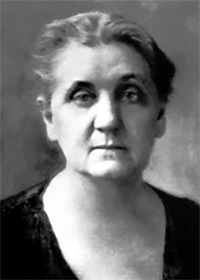
|
Jane Addams (September 6, 1860-May 21, 1935) won worldwide recognition in the first third of the twentieth century as a pioneer social worker in America, as a feminist, and as an internationalist. She was born in Cedarville, Illinois, the eighth of nine children. Her father was a prosperous miller and local political leader who served for sixteen years as a state senator and fought as an officer in the Civil War; he was a friend of Abraham Lincoln whose letters to him began «My Dear Double D-'ed Addams». Because of a congenital spinal defect, Jane was not physically vigorous when young nor truly robust even later in life, but her spinal difficulty was remedied by surgery. In 1881 Jane Addams was graduated from the Rockford Female Seminary, the valedictorian of a class of seventeen, but was granted the bachelor's degree only after the school became accredited the next year as Rockford College for Women. In the course of the next six years she began the study of medicine but left it because of poor health, was hospitalized intermittently, traveled and studied in Europe for twenty-one months, and then spent almost two years in reading and writing and in considering what her future objectives should be. At the age of twenty-seven, during a second tour to Europe with her friend Ellen G. Starr, she visited a settlement house, Toynbee Hall, in London's East End. This visit helped to finalize the idea then current in her mind, that of opening a similar house in an underprivileged area of Chicago. In 1889 she and Miss Starr leased a large home built by Charles Hull at the corner of Halsted and Polk Streets. The two friends moved in, their purpose, as expressed later, being «to provide a center for a higher civic and social life; to institute and maintain educational and philanthropic enterprises and to investigate and improve the conditions in the industrial districts of Chicago».
Miss Addams and Miss Starr made speeches about the needs of the neighborhood, raised money, convinced educated young women and men to join them, took care of children, nursed the sick, listened to outpourings from troubled people. By its second year of existence, Hull-House was host to two thousand people every week. There were kindergarten classes in the morning, club meetings for older children in the afternoon, and for adults in the evening more clubs or courses in what became virtually a night school. The first facility added to Hull-House was an art gallery, the second a public kitchen; then came a coffee house, a gymnasium, a swimming pool, a cooperative boarding club for girls, a book bindery, an art studio, a music school, a drama group, a circulating library, an employment bureau, a labor museum. The residents of Hull-House also conducted innovative empirical research on their neighborhood and actively worked to reform state and local government. Reforms championed by Addams and the residents of Hull-House include child labor laws, improved water, sewer and garbage collection, juvenile courts, workplace health and safety legislation, and women’s suffrage.
As her reputation grew, Miss Addams was drawn into larger fields of civic responsibility. In 1905 she was appointed to Chicago's Board of Education and subsequently made chairman of the School Management Committee; in 1908 she participated in the founding of the Chicago School of Civics and Philanthropy and in the next year became the first woman president of the National Conference of Charities and Corrections. In her own area of Chicago she led investigations on midwifery, narcotics consumption, milk supplies, and sanitary conditions, even going so far as to accept the official post of garbage inspector of the Nineteenth Ward, at an annual salary of a thousand dollars. In 1910 she received the first honorary degree ever awarded to a woman by Yale University.
Jane Addams was an ardent feminist. In the days before women's suffrage she believed that women should make their voices heard in legislation and therefore should have the right to vote, but more comprehensively, she thought that women should generate aspirations and search out opportunities to realize them.
For her own aspiration to rid the world of war, Jane Addams created opportunities or seized those offered to her to advance the cause. In 1906 she gave a course of lectures at the University of Wisconsin summer session which she published the next year as a book, Newer Ideals of Peace. She spoke for peace in 1913 at a ceremony commemorating the building of the Peace Palace at The Hague and in the next two years, as a lecturer sponsored by the Carnegie Foundation, spoke against America's entry into the First World War. In January, 1915, she accepted the chairmanship of the Women's Peace Party, an American organization, and four months later the presidency of the International Congress of Women convened at The Hague largely upon the initiative of Dr. Aletta Jacobs, a Dutch suffragist leader of many and varied talents. When this congress later founded the organization called the Women's International League for Peace and Freedom, Jane Addams served as president until 1929, as presiding officer of its six international conferences in those years, and as honorary president for the remainder of her life.
Publicly opposed to America's entry into the war, Miss Addams was attacked in the press and expelled from the Daughters of the American Revolution, but she found an outlet for her humanitarian impulses as an assistant to Herbert Hoover in providing relief supplies of food to the women and children of the enemy nations, the story of which she told in her book Peace and Bread in Time of War (1922).
After sustaining a heart attack in 1926, Miss Addams never fully regained her health. Indeed, she was being admitted to a Baltimore hospital on the very day, December 10, 1931, that the Nobel Peace Prize was being awarded to her in Oslo. She died in 1935 three days after an operation revealed unsuspected cancer. The funeral service was held in the courtyard of Hull-House.
Selected Bibliography
- Addams, Jane. An extensive collection of Miss Addams' papers is deposited in the Swarthmore College Peace Collection, Swarthmore, Pennsylvania.
- Addams, Jane, A Centennial Reader, ed. by E. C. Johnson, with a prefatory note on Jane Addams' life by W. L. Neumann and an introduction by William O. Douglas. New York, Macmillan, 1960.
- Addams, Jane, Democracy and Social Ethics. New York, Macmillan, 1902. Republished with an introductory life of Jane Addams by A. F. Scott. Cambridge, Mass., Harvard University Press, 1964.
- Addams, Jane, The Excellent Becomes the Permanent. New York, Macmillan, 1932.
- Addams, Jane, The Long Roal of Woman's Memory. New York, Macmillan, 1916.
- Addams, Jane, Newer Ideals of Peace. New York, Macmillan, 1907.
- Addams, Jane, Peace and Bread in Time of War. New York, Macmillan, 1922.
- Addams, Jane, The Second Twenty Years at Hull-House: September 1909 to September 1929. New York, Macmillan, 1930.
- Addams, Jane, The Spirit of Youth and the City Streets. New York, Macmillan, 1909.
- Addams, Jane, Twenty Years at Hull-House: With Autobiographical Notes. New York Macmillan, 1910.
- Curti, Merle, «Jane Addams on Human Nature», Journal of the History of Ideas, 22 (April-June, 1961) 240-253.
- Farrell, John C., Beloved Lady: A History of Jane Addams' Ideas on Reform and Peace. Baltimore, Johns Hopkins Press, 1967. Contains a major bibliography.
- Lasch, Christopher, The New Radicalism in America, 1889-1963: The Intellectual as a Social Type. London, Chatto & Windus, 1966.
- Linn, James W., Jane Addams: A Biography. New York, Appleton-Century, 1935.
- Tims, Margaret, Jane Addams of Hull House, 1860-1935. London, Allen & Unwin, 1961.
* Miss Addams did not deliver a Nobel lecture. Hospitalized at the time of the award ceremony in December, 1931, she later notified the Nobel Committee in April of 1932 that her doctors had decided it would be unwise for her to go abroad. 1. Jane Addams, The Second Twenty Years at Hull-House, p. 112.
From Nobel Lectures, Peace 1926-1950, Editor Frederick W. Haberman, Elsevier Publishing Company, Amsterdam, 1972. This autobiography/biography was written at the time of the award and first published in the book series Les Prix Nobel. It was later edited and republished in Nobel Lectures. To cite this document, always state the source as shown above
deliver |
| |
On the Editor |
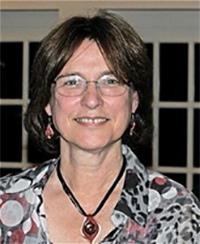 |
Dr. Patricia Shields is a Professor in the Department of Political Science. She received her BA in Economics from the University of Maryland College Park (1973). She further pursued her study in Economics at The Ohio State University by earning a Masters of Arts (1975) and finished her educational pursuit with a Ph.D. in Public Administration (1977). She began teaching at Texas State University in1978 and received tenure in 1984. Since her Texas State career began, she has received many awards for excellence in teaching such as the National Association for Schools of Public Affairs and Administration, Leslie A Whittington Excellence in Teaching Award (2002), The Texas State Presidential Award for Excellence in Teaching (2001), the Texas State Faculty Senate, Everette Swinney. Teaching Award (2010) as well as the Professor of the Year Award from the Central Texas Chapter of the American Society for Public Administration (2006). She has taught 10 graduate and undergraduate courses including statistics, public finance, public policy, public sector economics and research methods. Currently she focuses on the MPA Program capstone process and has supervised over 400 Applied Research Projects, many of which have won national and regional awards. She has published over 60 articles and book chapters in subjects such as public pricing, cut back management, privatization, the sunset review process, military recruitment, conscription, women in the military, military families, expeditionary and peacekeeping forces, positive peace, and military bureaucracies. She is most well-known for applying the philosophy of pragmatism to public administration and research methods in public administration. It was in this literature that she found the works of Jane Addams and Addams’s link to public administration. She has also published two books Step by Step: Building a Research Paper and A Playbook for Research Methods: Integrating Conceptual Frameworks and Project Management (with Nandhini Rangarajan) and an edited the Routledge Handbook of Research Methods in Military Studies (with Joseph Soeters and Sebastiaan Rietjens). In 1984 she won the Texas State Presidential Seminar research award and in 2007 she won the Public Administration Review Laverne Burchfield Award for the best review essay. In addition, professionally, she serves on the Editorial Board for Administration & Society and the Journal of Public Affairs Education. Finally, since 2001 she has served as Editor-in-Chief to Armed Forces and Society, the leading peer reviewed journal on civil-military relations.
Website: <http://www.polisci.txstate.edu/people/faculty/shields.html> |
| |
Important Links on Jane Addams
Selected Videos with and on Jane Addams
|
| |
|
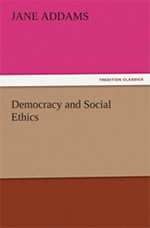 |
Addams, J. (1902).
Democracy and Social Ethics.
New York, NY: Macmillan. |
 |
Addams, J. (1907).
Newer Ideals of Peace.
New York, NY: Macmillan |
| |
|
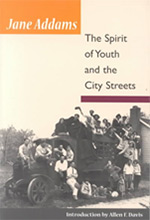 |
Addams, J. (1909).
The Spirit of Youth and the City Streets.
Urbana, IL: University of Illinois Press. |
 |
Addams, J. (1910).
Twenty years at Hull house.
New York, NY: MacMillan. |
| |
|
|
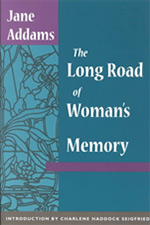 |
Addams, J. (1916).
Long Road of Women’s Memory.
New York, NY: Macmillan. |
 |
Addams, J. (1922).
Peace and Bread in Time of War.
New York, NY: MacMillan. |
| |
|
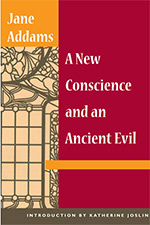 |
Addams, J. (1923).
A New Conscience and an Ancient Evil.
New York, NY: Macmillan. |
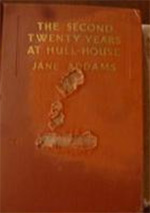 |
Addams, J. (1930).
The Second Twenty Years at Hull-House.
New York, NY: Macmillan. |
| |
|
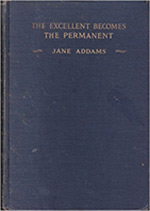 |
Addams, J. (1932).
The Excellent becomes Permanent.
New York, NY: MacMillan. |
 |
Addams, J. (1935).
My Friend Julia Lathrop.
New York, NY: Macmillan. |
| |
|
 |
Addams, J. Balch, E. and Hamilton, A. (1915).
Women at The Hague:
The International Congress of Women and its Results
New York, NY: Macmillan |
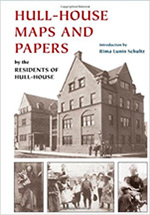 |
Residents of Hull-House. (1895).
Hull House Maps and Papers:
A Presentation of Nationalities and Wages
in a Congested Di¬strict of Chicago,
together with Comments and Essays on
Problems Growing Out
of the Social Conditions.
New York, NY: Thomas Crowell & Co. |
| |
|
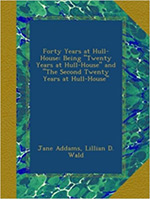 |
Jane Addams:
Forty Years at Hull House (1923) (with Lillian Wald)
This work combines Addams two if her books –
Twenty Years at Hull-House and
The Second Twenty Years at Hull-House. |
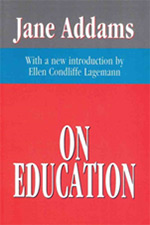 |
Jane Addams:
On Education (1994) Transaction Publishers.
This compilation of Addams writings on education
contains a forward by Ellen Condliffe. |
| |
|
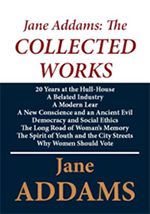 |
Jane Addams:
The Collected Works (1913) by Jane Addams
( Amazon Digital Services LLC) |
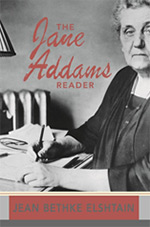 |
The Jane Addams Reader (2002)
selected works of Jane Addams
compiled by Jean Bethke
Elshtain. Basic Books. |
| |
|
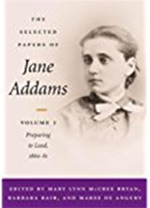 |
The Selected Works of Jane Addams Vol. 1:
Preparing to Lead 1860 – 1881. (2002)
Edited by M. Bryan, B. Bair and M. De Angury.
University of IllinoisPress.
This includes diary entries of her early years |
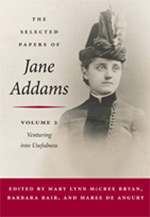 |
The Selected Works of Jane Addams Vol. 2:
Venturing into Usefulness. 1881- 1888 (2009)
Edited by M. Bryan, B. Bair and M. De Angury. |
| |
|
Books on Jane Addams |
|
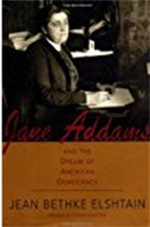 |
Jane Addams and the Dream of
American Democracy: A Life (2002)
by Jean Bethke Elshtain
Basic Books |
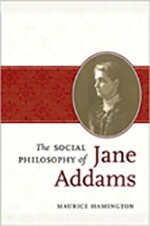 |
The Social Philosophy of Jane Addams (2009)
by Maurice Hamington
The University of Illinois Press |
| |
|
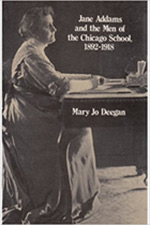 |
Jane Addams and the Men
of the Chicago School (1988)
by Mary Jo Deegan.
Transaction Books |
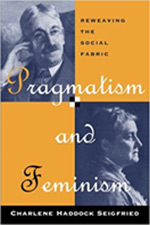 |
Pragmatism and Feminism:
Reweaving the Social Fabric (1996)
Charlene Haddock Seigfried
University of Chicago Press |
| |
|
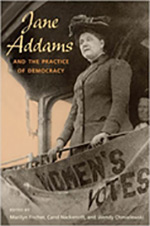 |
Jane Addams and the
Practice of Democracy (2009)
Edited by M. Fischer, C. Nackenoff and W. Chmielewski.
University of Illinois Press |
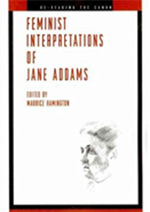 |
Feminist Interpretations of Jane Addams (2010)
Edited by Maurice Hamington.
Pennsylvania State University Press. |
| |
|
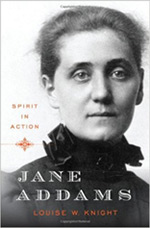 |
Jane Addams:
Spirit in Action
by Louise W. Knight
(New York: W. W. Norton & Company, 2010). |
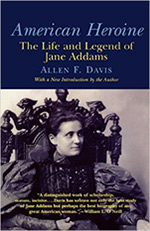 |
American Heroine:
The Live and Legend of Jane Addams (1973).
By Allen Davis,
Ivan R. Dee Publishers |
| |
|
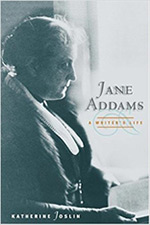 |
Jane Addams: A Writer’s Life (2004)
Katherine Josline
University of Illinois Press. |
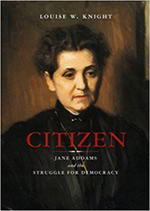 |
Citizen: Jane Addams and
the Struggle for Democracy (2005)
Louise Knight.
University of Chicago Press. |
| |
|

Authorized by the Texas Legislature in 1899, Southwest Texas State Normal School opened its doors in 1903. Over the years, the Legislature broadened the institution's scope and changed its name, in succession, to Southwest Texas State Normal College, Southwest Texas State Teachers College, Southwest Texas State College, Southwest Texas State University, and in 2003 to Texas State University. Each name reflects the university's growth from a small teacher preparation institution to a major, multipurpose university. Texas State's original mission was to prepare Texas public school teachers. It became renowned for carrying out this mission, but today it does far more.
Texas State's 38,808 students choose from 98 bachelor’s, 90 master’s and 12 doctoral degree programs offered by the following colleges: Applied Arts, McCoy College of Business Administration, Education, Fine Arts and Communication, Health Professions, Liberal Arts, Science and Engineering, University College and The Graduate College. As an Emerging Research University, Texas State offers opportunities for discovery and innovation to faculty and students.
Our students come from around the globe, and our student body is diverse. Fifty percent of Texas State students are ethnic minorities. Texas State ranks 14th in the nation for total bachelor’s degrees awarded to Hispanic students.
Texas State's San Marcos campus is located in a growing community of 60,000 people in the Austin Metropolitan Area. Located in the Texas Hill Country, where blackland prairies roll into beautiful hills, Texas State enjoys a setting that is unique among Texas universities.
The Texas State Round Rock Campus is located north of Austin. Students there can take upper-level courses leading to bachelor’s degrees and complete master’s degree and certificate programs. Students who complete their degree requirements at the Round Rock Campus earn their degrees from Texas State University.
The Texas State campus is as diverse as the students who live and learn here. Our hilly grounds are home to 209 buildings. Some, like Old Main, are as old as the university itself. Others, such as the Angelina and San Gabriel residence halls, opened in 2016, and more new buildings are scheduled for completion soon.
At The Meadows Center for Water and the Environment on the Texas State campus, you can see the second-largest springs in Texas through the floor of a glass-bottom boat or glass-bottom kayak. These springs feed the San Marcos River and are home to eight endangered species, including the Texas blind salamander. Our campus is one of the best places in the world to study aquatic ecosystems and species. |
|
|
|
|
|